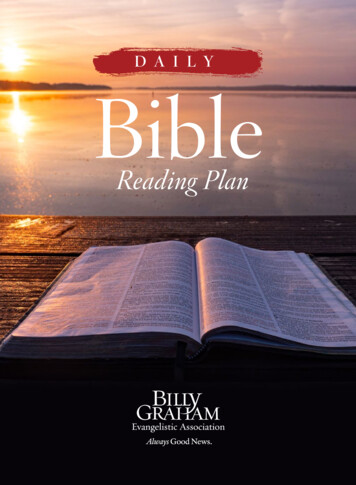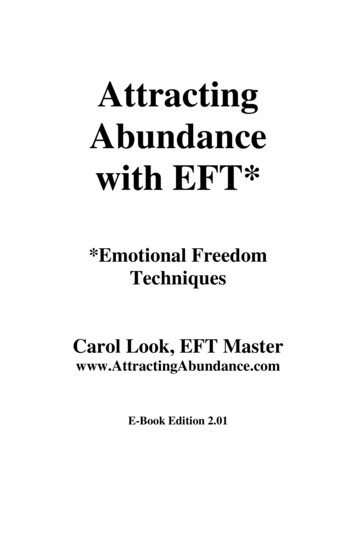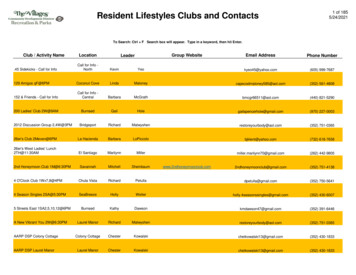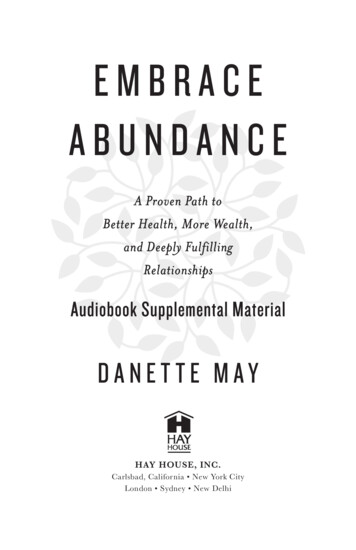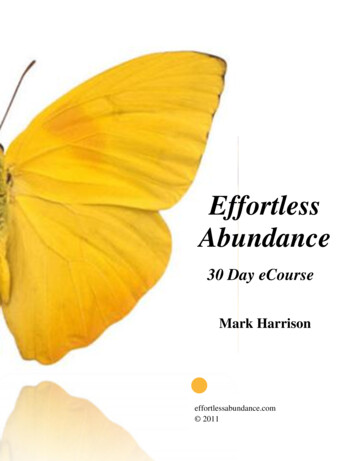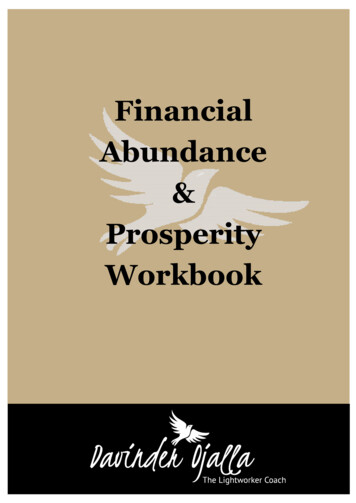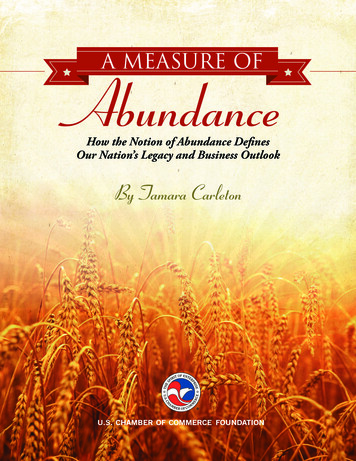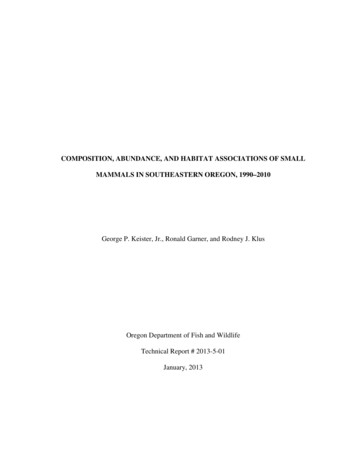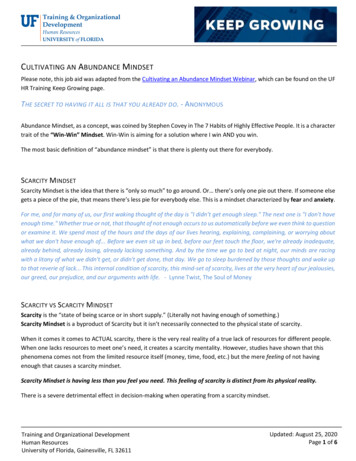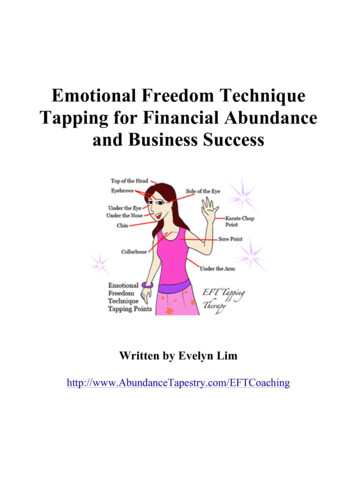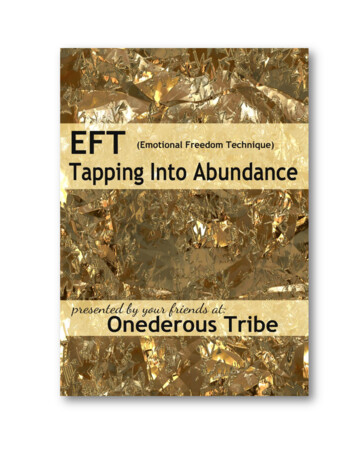
Transcription
AN ABUNDANCE OFJOHNGREEN
MeetJOHN GREEN
John Green is an award-winning, New YorkTimes–bestselling author whose many accoladesinclude the Printz Medal, a Printz Honor, and theEdgar Award. He has twice been a finalist for theLos Angeles Times Book Prize. With his brother,Hank, John is one half of the Vlogbrothers, oneof the most popular online video projects in theworld. You can join John’s 1.1 million followerson Twitter, or visit him online. John lives with hiswife and son in Indianapolis, Indiana.“The great and terrible beauty of the Internetnow makes it possible for us to continue thestrange conversation between reader and writerindefinitely.”—John GreenHere are some of the places you can catch JohnGreen online:The official John Green website:http://www.johngreenbooks.com/The Vlogbrothers video s Tumblr:http://fishingboatproceeds.tumblr.comFollow John on Twitter:http://www.twitter.com/realjohngreen
THE FAULT IN OUR STARSABOUT THE BOOKInsightful, Bold, Irreverent, and RawDespite the tumor-shrinking medical miracle that has bought hera few years, Hazel has never been anything but terminal, her finalchapter inscribed upon diagnosis. But when a gorgeous plot twistnamed Augustus Waters suddenly appears at Cancer Kid SupportGroup, Hazel’s story is about to be completely rewritten.The Fault in Our Stars is award-winning author John Green’s mostambitious and heartbreaking work yet, brilliantly exploring thefunny, thrilling, and tragic business of being alive and in love.H“In its every aspect, this novel is a triumph.”— Booklist, starred reviewH“An achingly beautiful story about life and loss.”— School Library Journal, starred reviewH“Greens signature style shines.”— Kirkus Reviews, starred reviewH“[A]n extended meditationon the big questions about life and death.”HC: 978-0-525-47881-2 · 17.99— The Horn Book, starred review
DISCUSSION QUESTIONS During a disagreement regarding Hazel’s attendance at SupportGroup, her mother tells her, “Hazel, you deserve a life.” Consider theirony of this statement. Why is Hazel so resistant to attending herSupport Group? Though she doesn’t acknowledge it, what might besome of the benefits of her attending? In what ways does Augustus’s introduction to Hazel’s world complicatematters for her? How does their relationship profoundly change her life? Augustus inquires about Hazel’s background and tells her, “Don’ttell me you’re one of those people who becomes their disease.” Inwhat ways do Augustus, Hazel, and Isaac fight to keep cancer fromdefining who they are? How do they work to prevent it from consumingall aspects of them? Though they are intended to inspire and motivate, why does Augustusfind humor in his family’s posted “Encouragements”? What canreaders glean about him based on his reaction? Though her all-time favorite book is An Imperial Affliction, Hazel sharesthat she doesn’t like telling people about it because “there are booksso special and rare and yours that advertising your affection feels likea betrayal.” What do you believe she means by this statement? Do youagree? Have you ever had a personal connection with a work of art? Ifso, what was it about the work that “spoke” to you? Hazel shares that through his novel, Peter Van Houten is the onlyperson who understands what it’s like to be dying and not have died.What is it about his perspective that makes Hazel feel so connectedto this author? Why does Hazel feel so desperate to find out what happens beyondthe ending of An Imperial Affliction. What does this indicate about herneed for understanding about what comes “after”? Compare the parent/child relationships in the story: Hazel andher parents and Augustus and his parents. To what extent are therelationships of these characters shaped by the world around them?To what extent do their relationships shape that world? After hearing Augustus state that he fears oblivion, Hazel tells him,“.even if we survive the collapse of our sun, we will not surviveforever.” How does her pragmatic understanding of the frailty ofhumanity help her remain grounded? Considering Hazel’s and Augustus’s perspectives, in what ways is TheFault in Our Stars a story about things that have been lost? What doeseach of them find along the way?
WILL GRAYSON, WILL GRAYSONABOUT THE BOOKWill Grayson, meet Will GraysonIn the suburbs of Chicago, two teens named Will Grayson—onegay, one straight—have lived their lives completely unaware ofthe other’s existence. But that changes one fateful night when theirworlds collide. Their lives begin to intertwine and each Will Graysonbegins to question who he really is. Their discoveries take them inunexpected directions, building toward romantic turns-of-heart andthe epic production of an oh-so-fabulous high school musical.New York Times BestsellerALA Children’s & Young Adult Stonewall Book Award HonorALA Best Fiction for Young Adults BookALA Rainbow Project Pick“Funny, rude and original.”HC: 978-0-525-42158-0 · 17.99PB: 978-0-14-241847-5 · 8.99By John Green and David Levithan—The New York Times Book Review
DISCUSSION QUESTIONS In what ways is Will Grayson’s life similar to Will Grayson’s? Howare they different? How does the style of the odd vs even chapterswork to help us understand both Will and Will as individuals? Doyou think one has a significantly easier life? Will Grayson states, “You cannot possibly pick your friends, or elseI never would have ended up with Tiny Copper.” What is it about hisrelationship with Tiny that he finds so difficult? Consider your ownfriendships—have you ever had a friend that you felt required anextra effort on your part to remain friends? Will shares with readers that emotion is easy to resist “if youfollow two simple rules: 1. Don’t care too much. 2. Shut up.” Whatcan readers infer about Will from this statement? Do you thinkthis is sage advice? Describe Will’s home life; using examples, share how hisrelationship with his mom shaped him as a person. Why does hesee his mother as fragile? How does Will’s relationship with hismother change and what does will discover about her? From your experience, do you think it’s difficult for most people to reachout for help? Consider the characters in the novel; who do they turn tofor assistance? To whom do you turn when you are in need? Why is Will’s relationship with Issac so important to him? Whatdoes learning the truth about who Isaac really is force will to do? Beyond his size, what is it about Tiny’s presence that makes Will feel notso alone? Why is it so important that Will befriends Tiny when he does? Why is Will and Will’s final gift to Tiny so important? What does thisact signify about the Will Graysons understanding of friendship?Have you ever gone to such great lengths to let a friend or lovedone know what they mean to you?
PAPER TOWNSABOUT THE BOOKWhere. Is. Margo?Quentin Jacobsen has spent a lifetime loving the magnificentlyadventurous Margo Roth Spiegelman from afar. So when she cracksopen a window and climbs back into his life—dressed like a ninja andsummoning him for an ingenious campaign of revenge—he follows.After their all-nighter ends and a new day breaks, Q arrives atschool to discover that Margo, always an enigma, has now become amystery. But Q soon learns that there are clues—and they’re for him.Urged down a disconnected path, the closer he gets, the less Q seesof the girl he thought he knew. With nothing left to guide him but aseemingly random collection of maps, books, online entries, and anannotated copy of Walt Whitman’s Leaves of Grass, Q and his friendsmust find Margo and unpeel the ever-changing layers of meaningbehind her “paper towns.”New York Times BestsellerEdgar Award WinnerSchool Library Journal Best BookH“Wonderfully witty.”H“Profoundly moving.”—Booklist, starred reviewHC: 978-0-525-47818-8 · 17.99PB: 978-0-14-241493-4 · 9.99—School Library Journal, starred review
DISCUSSION QUESTIONS When Margo and Quentin are nine they make a horrible discovery, andrespond in very different ways. Quentin says, “As I took those two stepsback, Margo took two equally small and quiet steps forward.” Do thesedescriptions still apply to the characters when they reach high school?When the story ends? What changes? Describe Q’s best friends. Where do they fit into the caste system of WinterPark High? If you had to choose one of these characters as your best friendwho would you pick and why? When Margo disappears, she’s always been known to leave “a bit of abread crumb trail.” What clues does Margo leave for Quentin? How arethese different from clues left previously? Discuss what Q finds in the abandoned mini-mall and how the bookcontributes both to the plot of the story and to what he ultimately learnsabout Margo and about himself. The definition of a “paper town” changes many times in the book.Describe the evolution of its meaning. How does it relate to the mystery?To the themes of the book? With which character’s version of the “real” Margo do youmost agree? Q’s parents describe people as “mirrors” and “windows.” What does thismean? Do you agree with this metaphor? Q comes to this conclusion: “Margo was not a miracle. She was not anadventure. She was not a fine and precious thing. She was a girl.” Discuss. Discuss the last line of the book, how it relates to the rest of the story, andwhat it ultimately says about Margo and Q’s relationship. Do you think the characters Margo targets for revenge get what theydeserve? Does Lacey deserve to be included? When Margo disappears after her outing with Q, it’s not the first time she’sseemingly vanished for a long period. Describe Margo’s other adventuresand note any common threads between the trips. What makes herdisappearance after her night with Q different from the others? Which philosophy of life do you most agree with: Margo’s Strings?Whitman’s Grass? Or Q’s Cracked Vessel? Why?
AN ABUNDANCE OF KATHERINESABOUT THE BOOK19 Katherines and counting.When it comes to relationships, Colin Singleton’s type is girls namedKatherine. And when it comes to girls named Katherine, Colin is alwaysgetting dumped. Nineteen times, to be exact. On a road trip milesfrom home, this anagram-happy, washed-up child prodigy has tenthousand dollars in his pocket, a bloodthirsty feral hog on his trail, andan overweight, Judge Judy–loving best friend riding shotgun—but noKatherines. Colin is on a mission to prove The Theorem of UnderlyingKatherine Predictability, which he hopes will predict the future of anyrelationship, avenge Dumpees everywhere, and finally win him the girl.Love, friendship, and a dead Austro-Hungarian archduke add up tosurprising and heart-changing conclusions in this ingeniously layeredcomic novel about reinventing oneself.ALA Michael L. Printz Honor BookALA Best Book for Young AdultsLos Angeles Times Book Prize FinalistBooklist Editors’ ChoiceKirkus Reviews Best Book of the YearHorn Book Fanfare List selectionH“Fully fun, challengingly complex and entirely entertaining.”—Kirkus Reviews, starred reviewH “Laugh-out-loud funny.”HC: 978-0-525-47688-7 · 16.99PB: 978-0-14-241070-7 · 8.99—The Horn Book, starred review
DISCUSSION QUESTIONS Colin spends most of the story devising a formula to predict romanticsuccess. If it worked, would you use it? Why or why not? Visitsparksflyup.com to try the formula yourself! John Green uses footnotes throughout the book. How does this changethe way you read the story? Did you interact with the text in a differentway? How? A n Abundance of Katherines is written in the third person. JohnGreen’s first book, Looking for Alaska, is written in the first person.How does the difference impact the book? Do you prefer one over theother? Why? Why do you think the author made the decision to try athird-person voice in his second book? What does Colin learn about storytelling? Why is this important? How doesthis change his understanding of his past and current relationships? Do you agree that Colin was always the dumpee? Do you think his wasever responsible for the breakup? What purpose does anagramming words serve for Colin? In what waysdoes this activity connect/isolate him from others? Throughout the novel, readers witness the complexities of the variousrelationships among the characters. Consider whose relationshipseemed most similar to one of your own personal relationships. Whatabout it reminded you of your experiences? Lindsey tells Colin, “How you matter is defined by the things that matterto you.” Do you agree with her assessment? Why or why not? After a moment of self-actualization, Hassan tells Colin, “I’m a not-doer.” What does he mean by this assessment of himself? Why does hepledge that he will change? Consider passivity in others; are there timesthat this can prove to be hurtful or harmful? Offer some examples. While desperately trying to fix his Theorem, Colin cries, “Eureka.I figured something out. The future is unpredictable.” Thoughmost people would find his observation obvious, why does Colin’sunderstanding of this fact prove to be so profound? In what waysdoes this discovery signify the evolution in Colin’s understanding ofthe power of story?
LOOKING FOR ALASKAABOUT THE BOOKBefore and After.Miles “Pudge” Halter is abandoning his safe–okay, boring–life. Fascinatedby the last words of famous people, Pudge leaves for boarding school toseek what a dying Rabelais called the “Great Perhaps.”Pudge becomes encircled by friends whose lives are everything butsafe and boring. Their nucleus is razor-sharp, sexy, and self-destructiveAlaska, who has perfected the arts of pranking and evading school rules.Pudge falls impossibly in love. When tragedy strikes the close-knit group,it is only in coming face-to-face with death that Pudge discovers thevalue of living and loving unconditionally.ALA Michael L. Printz Award WinnerALA Best Book for Young AdultsALA Quick Pick for Reluctant Young Adult ReadersLos Angeles Times Book Prize FinalistBooklist Editors’ ChoiceKirkus Reviews Best Book of the YearHC: 978-0-525-47506-4 · 16.99PB: 978-0-14-240251-1 · 8.99School Library Journal Best Book of the Year
SOME INTENTIONALLY VAGUE AND BROAD DISCUSSION QUESTIONSBY MR. JOHN GREEN Is forgiveness universal? I mean, is forgiveness really availableto all people, no matter the circumstances? Is it, for instance,possible for the dead to forgive the living, and for the living toforgive the dead? I would argue that both in fiction and in real life, teenagesmoking is a symbolic action. What do you think it’s intendedto symbolize, and what does it actually end up symbolizing?To phrase this question differently: Why would anyone ever paymoney in exchange for the opportunity to acquire lung cancerand/or emphysema? Do you like Alaska? Do you think it’s important to like people youread about? By the end of this novel, Pudge has a lot to say about immortalityand what the point of being alive is (if there is a point). To whatextent do your thoughts on mortality shape your understanding oflife’s meaning? How would you answer the old man’s final question for hisstudents? What would your version of Pudge’s essay look like? Discuss the book’s unusual structure. Why do you suppose Greenchose this format for telling his story? How else might he havestructured the material? Miles tells the story in his own first-person voice. How might thebook differ if it had been told in Alaska’s voice or the Colonel’s? Orin the voice of an omniscient narrator? Dr. Hyde says, “Everything that comes together falls apart.” Doyou think the author agrees? How is this Zen belief explored inthe novel? Alaska loves these two lines from W. C. Auden: “You shall love yourcrooked neighbor / With your crooked heart.” What do these linesmean to you and why do you think Alaska likes them so much?
AND NOW A WORDQ: Your first book, Looking for Alaska, was published just five yearsafter you graduated from college. Did you always plan on being anovelist, and what drew you specifically to YA?A: I always liked writing and dreamt of being able to publish books, butI never intended to write for a living (and I still don’t, really--I do, andenjoy, many other kinds of work). As for why I write for teenagers, Isuppose it’s because I find teenagers, both as readers and ascharacters, more interesting than I find adults. (Sorry, adults! Thankyou for reading my books and everything, but, yeah, I just don’t.like.care about you very much.) Teenagers are doing so much for the firsttime: falling in love, encountering mortality, experiencing the great andterrible burden of sovereignty, and asking the big existential questionsabout whether there is a point to being alive. Because all of this is sonew and exciting, they’re able to think about it (and I’m able to writeabout it) without ironic distance or self-consciousness that tends toaccompany adulthood.Q: You’ve published several successful works in a short amount oftime. Tell us a bit about how you organize your writing schedule.A: In retrospect, it happened in a relatively short period of time, but eachof the books took three or four years, which seemed long at the time.The truth is, I’m not nearly as organized or prolific as I’d like to be. I tryto write each morning between eight and noon, and then I spend myafternoons working on videos and other projects, but I delete the vastmajority of what I write.Q: From Looking for Alaska to The Fault in Our Stars, you don’t shyaway from young adult issues like drug use, emerging sexuality,conflicts with parents, depression. What kind of feedback do teensgive you about that approach?A: I’ve received more than ten thousand emails in the last six yearsfrom teenagers, and zero of them--actually and literally zero--haveexpressed any kind of concern or discomfort with the so-called “maturecontent” in my books. I think this is because contemporary teens areexcellent critical readers--they’ve learned critical discernment notonly in their English classes but from their countless encounters withmultivalent and ambiguous messaging in advertising and televisionshows and their own interpersonal relationships. They assume (rightly)
FROM THE AUTHOR:that novels are not manuals for how to live one’s life, but insteadattempts to reveal some true things through made-up stories.Q: T he Fault in Our Stars has a lot of very detailed information on what it’slike to be a sick teenager and different types of cancer treatments.What kind of research did you do to learn about all that? Any bigsurprises/unexpected forks in the road during your research?A: Well, cancer (and everything else) is treated fictitiously in the novel, soin many cases I made up treatments or embraced improbabilities thatsuited the story. That said, I did read a lot about cancer in the years Iwas working on The Fault in Our Stars. I also received lots of help fromtalking with people living with cancer and their families. I was also veryfortunate to be able to call upon the expertise of my father-in-law, whois a surgical oncologist.Q: In your author’s note, you urge readers not to assume the The Faultin Our Stars is based on your own real-life experiences, and toappreciate it as fiction. Are those sorts of questions something youdeal with a lot as a writer of fiction?A: Many of the people reading The Fault in Our Stars, especially at first,will be aware that I was friends with Esther Earl, a teenager whosecancer was similar to the cancer Hazel has in the book. The Fault inOur Stars was profoundly shaped by Esther and my affection for her.Many of my readers will also know that I worked as a student chaplainat a children’s hospital for five months shortly after I graduated fromcollege, and that ever since I’ve been trying to write a novel about teensliving with chronic illness. Many of the kids I met as a chaplain inspiredpieces of this book, too. But it is still a novel, and it’s very important tome that it be read as fiction. Readers do often ask me which parts ofmy books are taken from real life. I think it’s natural to be curious aboutsuch things, particularly because readers see a lot of my life on Twitterand Tumblr and YouTube. But inside of a book, I’ve always felt like thewriter’s job is to disappear as much as humanly possible.Q: What can you tell us about what you’re working on next?A: Oh, I have no idea. I’ve been working for a while on a story set in tunnelsunderneath Paris and Moscow, but who knows. Ask me in hopefullyless-than-four-years.
HOW TO STARTYOUR OWN BOOK CLUBThink it would be hard to start your own book club? Think again!All you need is a little bit of organization and some friendswho are as excited about the books they read as you are.HERE ARE A FEW TIPS TO GET YOU STARTED:The best way to find people to be in your reading group is to ask your friends.Think of all the people you know who like to read, and ask them to join. If youstill don’t feel like you have enough people, ask each of your friends to bringsomeone else. You can usually get a good discussion going with six to eightpeople, but any number that is comfortable for you will work. If you’re havingtrouble finding enough cool people to form your reading group, check with yourschool, local library, or bookstore to see if there’s a group that you can join.Figure out when and where you want to meet.Some groups meet once a month, some meet every other month. You couldget together at someone’s house, in a park, on the beach, or in your school’slibrary. If it sounds too official and overwhelming to decide all the “wheres”and “whens” right now, don’t worry! It’s your group and so you get to make allthe decisions. All you have to do is get together once, and you can work out therest of the details later.Decide how you will choose books and how the discussions will be run.Maybe you have a favorite author that you and your friends would like to focuson. Or maybe you want to take turns picking your favorite book. Maybe oneperson likes to talk and would like to lead the discussion, or maybe you wouldrather just all get together and talk about the books you are reading. If youget stuck, you can often find discussion questions online (try the publisher’swebsite) or at your local library or bookstore.The most important thing to remember is that there’s no right or wrong way tohave a reading group. Do what you’re comfortable with and always have fun,and your group will be a success!For more discussion guides to get your group going, visitwww.penguin.com/teachersandlibrarians.Dutton Children’s Books SpeakDivisions of Penguin Young Readers Groupwww.penguin.com/teachersandlibrariansThis discussion guide has been provided by Penguin Young Readers Group for classroom,library, and reading group use. It may be reproduced in its entirety or excerpted for these purposes.@thepenguinpeeps978-3-00-200228-9
HC: 978--525-42158- · 17.99 PB: 978--14-241847-5 · 8.99 By John Green and David Levithan "Funny, rude and original." —The New York Times Book Review ABOUT THE BOOK Will Grayson, meet Will Grayson In the suburbs of Chicago, two teens named Will Grayson—one gay, one straight—have lived their lives completely unaware of the other .
